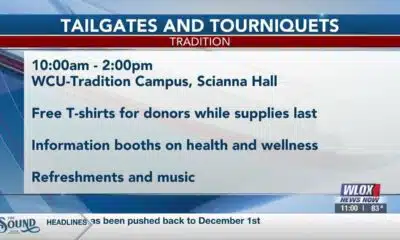News from the South - North Carolina News Feed
Helene took entire families, couples, children • Asheville Watchdog
They perished under the most harrowing circumstances: entire families swept away by raging floodwaters, couples tossed out of their homes or crushed as the land underneath gave way, people battling diseases unable to access the treatments that kept them alive.
The devastating, heartbreaking picture of the lives lost in Buncombe to Tropical Storm Helene, a calamity few could have imagined, is just beginning to emerge.
In the initial days after the storm, Buncombe Sheriff Quentin Miller put the death toll at 72, but his office has since clarified that that number included all deaths, and some were not hurricane-related or from Buncombe. State medical examiners are in charge of determining disaster-related fatalities, and their official count for Buncombe as of Friday was 42.
Asheville Watchdog is bringing you the stories behind the staggering loss of life, the children, parents, grandparents, multiple generations of a single family, all gone in one of the worst natural disasters to hit the mountains of western North Carolina. This is the first installment.
Judy and James Dockery
Judy and James Dockery lived atop a knoll in Swannanoa on land that had been in the family for decades. A small creek ran through, barely ankle deep.
Previous heavy rainfalls caused some flooding, but the water “would always go down the road and down the other side,” said their son, Bruce.
Judy, 64, and James, 63, did not think Helene would be different and remained in their trailer as the storm came through on Sept. 26-27, dumping 13 inches of rain near Swannanoa.
“There was an aquifer at the top of the mountain that blew,” Bruce Dockery said. A geyser of water roared down toward the Dockerys, unleashing a landslide that destroyed everything in its path.
Wes Barnett, who runs Satya Sanctuary, a meditation retreat next door to the Dockerys, saw his neighbors gathering out front just after the mud settled. They had discovered James Dockery on the ground, steps from where his trailer had stood.
“He couldn’t communicate,” Barnett said. “You could tell he had been crushed somehow.”
The neighbors carefully lifted Dockery out, trudging through mud and fallen trees. They fashioned a stretcher out of two-by-fours, making their way to a truck, their only hope for finding medical attention with cell service out and no way to call 911, Barnett said.
Bruce Dockery, who lives in Black Mountain, desperately tried to reach his parents. “There was no way to get” there, he said. On U.S. 70, “there were houses in the road, literally, trailers and sheds sitting in the road,” he said.
He tried an alternate route, Davidson Road, but “all of those smaller bridges were gone,” he said. “I found some cops directing traffic, and I was able to get a hold of them, and they were able to use radios” to call for help.
The neighbors tending to James Dockery were also searching for his wife. One said “they didn’t think Judy made it,” Barnett said. “And that’s when I could tell [James] kind of started letting go.”

The neighbors tried CPR but could no longer detect a pulse. “They held his hand until he passed,” Bruce Dockery said.
One of the neighbors found Judy Dockery several hours later. “She was probably a quarter of a mile down, about three streets down, on a rock covered in mud,” her son said.
Dockery thought his mother was still alive and set out on foot for a 2-mile journey through woods to reach her. About halfway there around dusk, he received a call that she had died.
“I sat on a log and cried for a few minutes” and decided to turn around, Dockery said.
The neighbors “put a blanket over and stayed with her until help arrived” the next day, he said. They took turns, he said, making sure that animals did not disturb her body.
Judy drowned, and James died from landslide injuries, according to their death certificates.
Dockery said he believes his parents were attempting to flee their trailer. “My dad, he was old school. He did not go outside unless he was fully dressed, and when they found him, he had his pajamas on, but he had his wallet and keys and knife,” he said.
The torrent of water and debris left “SUV-sized rocks” in the Dockerys’ yard, their son said. “There is a complete bald spot, probably 20 feet wide, all the way up the mountain where that spring under that creek just blew.”
A truck that James and his son had been rebuilding and Judy’s car “are just completely unaccounted for,” Dockery said. “They’re nowhere to be found.”
The Dockerys’ trailer was sheared in two with half ending up in a road below their driveway and the other half three streets away, slamming into a house and knocking it off its foundation, Dockery said. That house, he said, settled into the garage of the house next door.

The Dockerys “deeply loved each other,” their obituary said.
James, a Buncombe native, played guitar and enjoyed making others laugh. He was a preacher at Victory Baptist Church in Black Mountain. A former arborist, he had been unable to work in recent years due to health problems, his son said.
Judy was known as “Mama” or “Aunt Judy” and loved serving, cooking and caring for others, their obituary said. She had retired in February after working factory jobs and in nursing homes, her son said.
“My dad was a really avid outdoorsman, and my mom loved crafts, any kind of craft,” Bruce Dockery said.
The couple would have celebrated their 44th wedding anniversary Oct. 14.
James Harbison
James “Jimmy” Harbison of Swannanoa, a disabled U.S. Army veteran, loved to visit his cousins nearby. His sister, Norma, warned him to stay home as Helene approached.
“I said, ‘This is not just a rain. It’s a hurricane. Do not leave this house,’ ” she recalled.

Harbison dismissed her concern. On Sept. 27, as rivers and streams suddenly swelled with floodwater, Norma Harbison received a call from her cousin.
Jimmy Harbison, 71, was attempting to cross the creek to her house, a normally calm stream no more than knee deep. From a hilltop, Harbison’s cousin yelled, “Go back, go back, go back,” Norma Harbison recalled. “And she said he reached for the [bridge] railing, and the water like swept his feet right under him.”
She said her brother was a good swimmer. “In his head, he probably thought he could swim,” she said. “That water was running so hard…It washed the bridge completely out.”
Norma Harbison’s son and other relatives looked for Jimmy, but the creek had risen to more than 12 feet deep, she said.
Harbison’s body was discovered two days later. The cause of death was drowning.
A welder, Harbison loved to sketch cartoon characters and attended the River of Life International church in West Asheville, his sister said. He was a paratrooper in the Army’s 82nd Airborne Division and had been discharged for health reasons, she said.
“Jimmy was well known with the people in Swannanoa/Asheville,” Harbison said. He “spoke to everyone he came in contact with.”
Harbison lived with his sister for more than 30 years. “I was devastated and still am,” she said.
Patrick McLean
Patrick Andrew “Drew” McLean, 45, of Black Mountain was swept away by floodwaters.
Born in Charlotte, he excelled at school, winning an oratory contest and participating in theater productions and the debate team, according to his obituary.

He majored in filmmaking at the University of North Carolina School of the Arts and achieved his bucket list of watching 100 classic movies, the obituary said.
He enjoyed painting, writing, illustrating and photography. “From pen and ink sketching to hand-painting gifts,” his vision and ideas were unique, according to the obituary. He was the youngest person to be honored as Southern Highland Craft Guild’s Volunteer of the Year.
“Drew gravitated towards people with whom Christ’s love could be shared,’ the obituary said. He “admired global peacekeepers and followed their teachings” and read historical biographies.
He mentored church youth in Beaufort, South Carolina, and at-risk youth in an outdoor therapeutic program in Tennessee.
McLean’s body was found Oct. 7 at the Grove Stone & Sand Company’s quarry in Black Mountain.
His mother said the family was too distraught for an interview.
His father, Ronald, wrote in his obituary: “If you feel grief over Drew’s passing, may it pass quickly. If you had a part of him in your heart, be warmed by his spirit as he embraced friends and strangers with the same humor and compassion. Celebrate the time he had with you in your own way. He loved everyone he shared time with while he was here. I will carry his memories with me and have comfort in them.”
Patricia Radford
Patricia Radford, 84, died at her nursing home, Flesher’s Fairview Health & Retirement Center, on Sept. 29 of cardiovascular disease. “Utilities failure” and Hurricane Helene are listed as contributing conditions on her death certificate.
Her son, Chuck, said he lost cell service as the storm moved through and could not reach the nursing home. He received a message Sept. 30 to contact Flesher’s.
“I made my way up, went through the barricades, got up there, and they told me she had passed,” he said.
Radford said he had not been told what happened.
“Did they lose power? Did that have an effect?” he said. “Did they have short staff? Did that have an effect?”
Nursing home administrators did not respond to an email with questions from The Watchdog.
Radford said his mother had been “in declining health, but we did not as a family, and from the doctors, did not feel like this was imminent.”
A former bank manager, Patricia Radford was “a loving mother, and she was a very loving grandmother,” her son said.
“She took care of my kids, I have two, when they were growing up, her and my dad,” he said. “They were primary caretakers while my wife and I worked.”
Investigative reporter Victoria A. Ifatusin contributed to this report.
Asheville Watchdog is a nonprofit news team producing stories that matter to Asheville and Buncombe County. Sally Kestin is a Pulitzer Prize-winning investigative reporter. Email skestin@avlwatchdog.org. The Watchdog’s reporting is made possible by donations from the community. To show your support for this vital public service go to avlwatchdog.org/support-our-publication/.
Related
The post Helene took entire families, couples, children • Asheville Watchdog appeared first on avlwatchdog.org
News from the South - North Carolina News Feed
White House officials hold prayer vigil for Charlie Kirk
SUMMARY: Republican lawmakers, conservative leaders, and Trump administration officials held a prayer vigil and memorial at the Kennedy Center honoring slain activist Charlie Kirk, founder of Turning Point USA. Kirk was killed in Utah, where memorials continue at Utah Valley University and Turning Point USA’s headquarters. Police say 22-year-old Tyler Robinson turned himself in but has not confessed or cooperated. Robinson’s roommate, his boyfriend who is transitioning, is cooperating with authorities. Investigators are examining messages Robinson allegedly sent on Discord joking about the shooting. Robinson faces charges including aggravated murder, obstruction of justice, and felony firearm discharge.
White House officials and Republican lawmakers gathered at the Kennedy Center at 6 p.m. to hold a prayer vigil in remembrance of conservative activist Charlie Kirk.
https://abc11.com/us-world/
Download: https://abc11.com/apps/
Like us on Facebook: https://www.facebook.com/ABC11/
Instagram: https://www.instagram.com/abc11_wtvd/
Threads: https://www.threads.net/@abc11_wtvd
TIKTOK: https://www.tiktok.com/@abc11_eyewitnessnews
News from the South - North Carolina News Feed
Family, friends hold candlelight vigil in honor of Giovanni Pelletier
SUMMARY: Family and friends held a candlelight vigil in Apex to honor Giovanni Pelletier, a Fuquay Varina High School graduate whose body was found last month in a Florida retention pond. Giovanni went missing while visiting family, after reportedly acting erratically and leaving his cousins’ car. Loved ones remembered his infectious smile, laughter, and loyal friendship, expressing how deeply he impacted their lives. His mother shared the family’s ongoing grief and search for answers as authorities continue investigating his death. Despite the sadness, the community’s support has provided comfort. A celebration of life mass is planned in Apex to further commemorate Giovanni’s memory.
“It’s good to know how loved someone is in their community.”
More: https://abc11.com/post/giovanni-pelletier-family-friends-hold-candlelight-vigil-honor-wake-teen-found-dead-florida/17811995/
Download: https://abc11.com/apps/
Like us on Facebook: https://www.facebook.com/ABC11/
Instagram: https://www.instagram.com/abc11_wtvd/
Threads: https://www.threads.net/@abc11_wtvd
TIKTOK: https://www.tiktok.com/@abc11_eyewitnessnews
News from the South - North Carolina News Feed
NC Courage wins 2-1 against Angel City FC
SUMMARY: The North Carolina Courage defeated Angel City FC 2-1 in Cary, ending their unbeaten streak. Monaca scored early at the 6th minute, followed by Bull City native Brianna Pinto’s goal at the 18th minute, securing a 2-0 halftime lead. Angel City intensified in the second half, scoring in the 88th minute, but the Courage held firm defensively to claim victory. Pinto expressed pride in the win, emphasizing the team’s unity and playoff ambitions. Nearly 8,000 fans attended. Coverage continues tonight at 11, alongside college football updates, including the Tar Heels vs. Richmond game live from Chapel Hill.
Saturday’s win was crucial for the Courage as the regular season starts to wind down.
https://abc11.com/post/north-carolina-courage-wins-2-1-angel-city-fc/17810234/
Download: https://abc11.com/apps/
Like us on Facebook: https://www.facebook.com/ABC11/
Instagram: https://www.instagram.com/abc11_wtvd/
Threads: https://www.threads.net/@abc11_wtvd
TIKTOK: https://www.tiktok.com/@abc11_eyewitnessnews
-
News from the South - Kentucky News Feed6 days ago
Lexington man accused of carjacking, firing gun during police chase faces federal firearm charge
-
News from the South - Arkansas News Feed7 days ago
Group in lawsuit say Franklin county prison land was bought before it was inspected
-
The Center Square6 days ago
California mother says daughter killed herself after being transitioned by school | California
-
News from the South - Arkansas News Feed6 days ago
Arkansas medical marijuana sales on pace for record year
-
Local News Video6 days ago
William Carey University holds 'tailgates and tourniquets' blood drive
-
News from the South - Missouri News Feed6 days ago
Local, statewide officials react to Charlie Kirk death after shooting in Utah
-
Local News6 days ago
US stocks inch to more records as inflation slows and Oracle soars
-
News from the South - Alabama News Feed6 days ago
Zaxby's Player of the Week: Dylan Jackson, Vigor WR













































